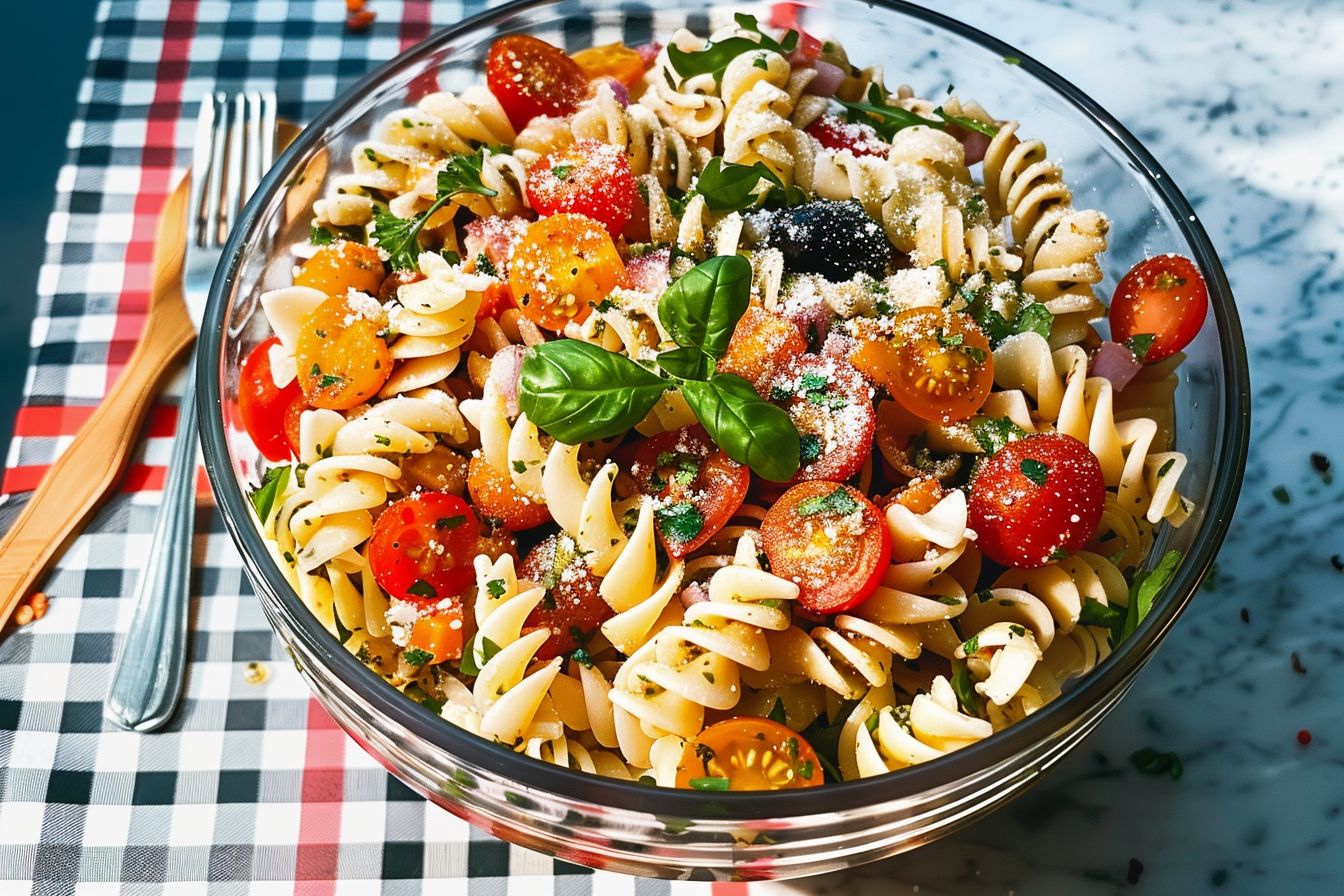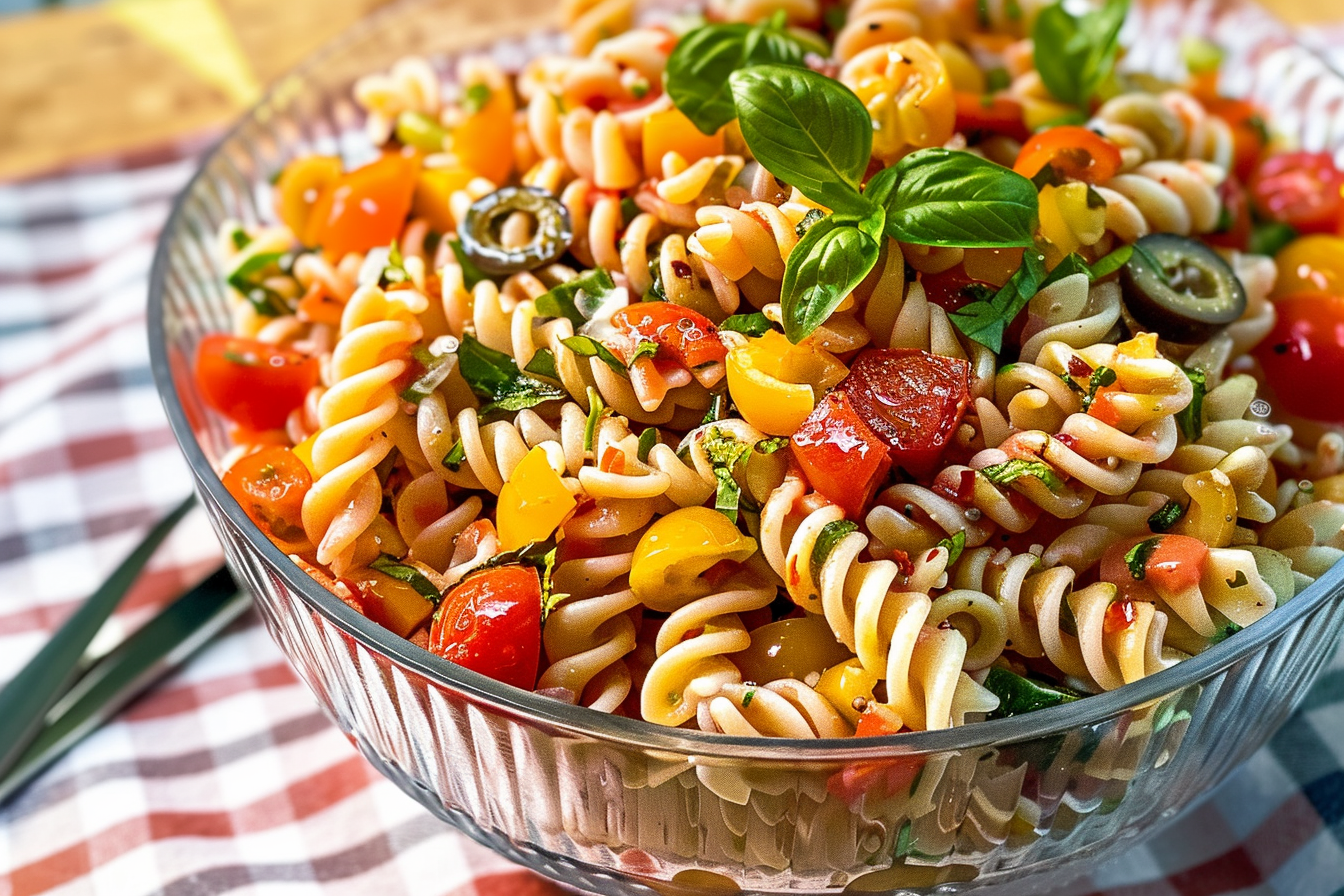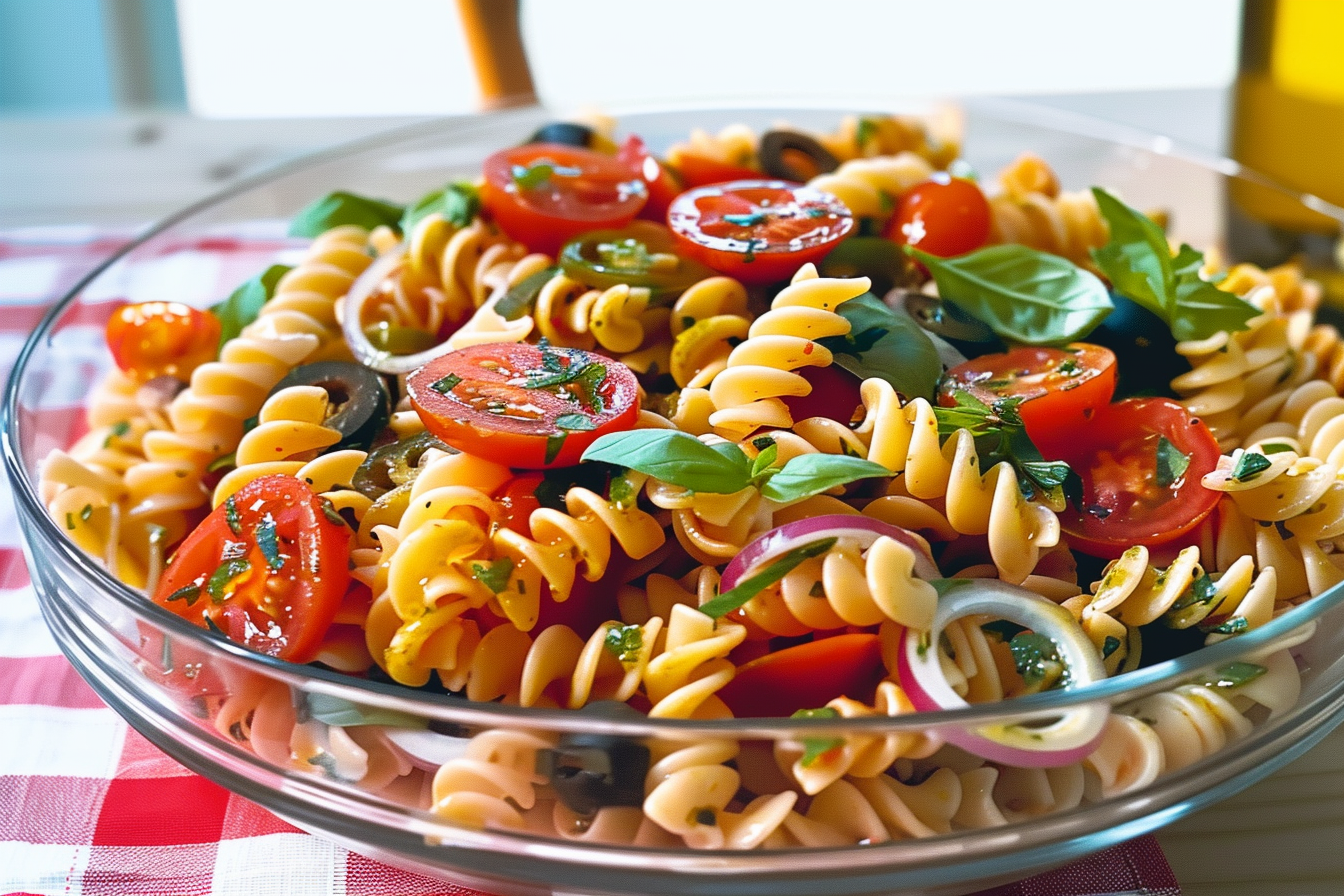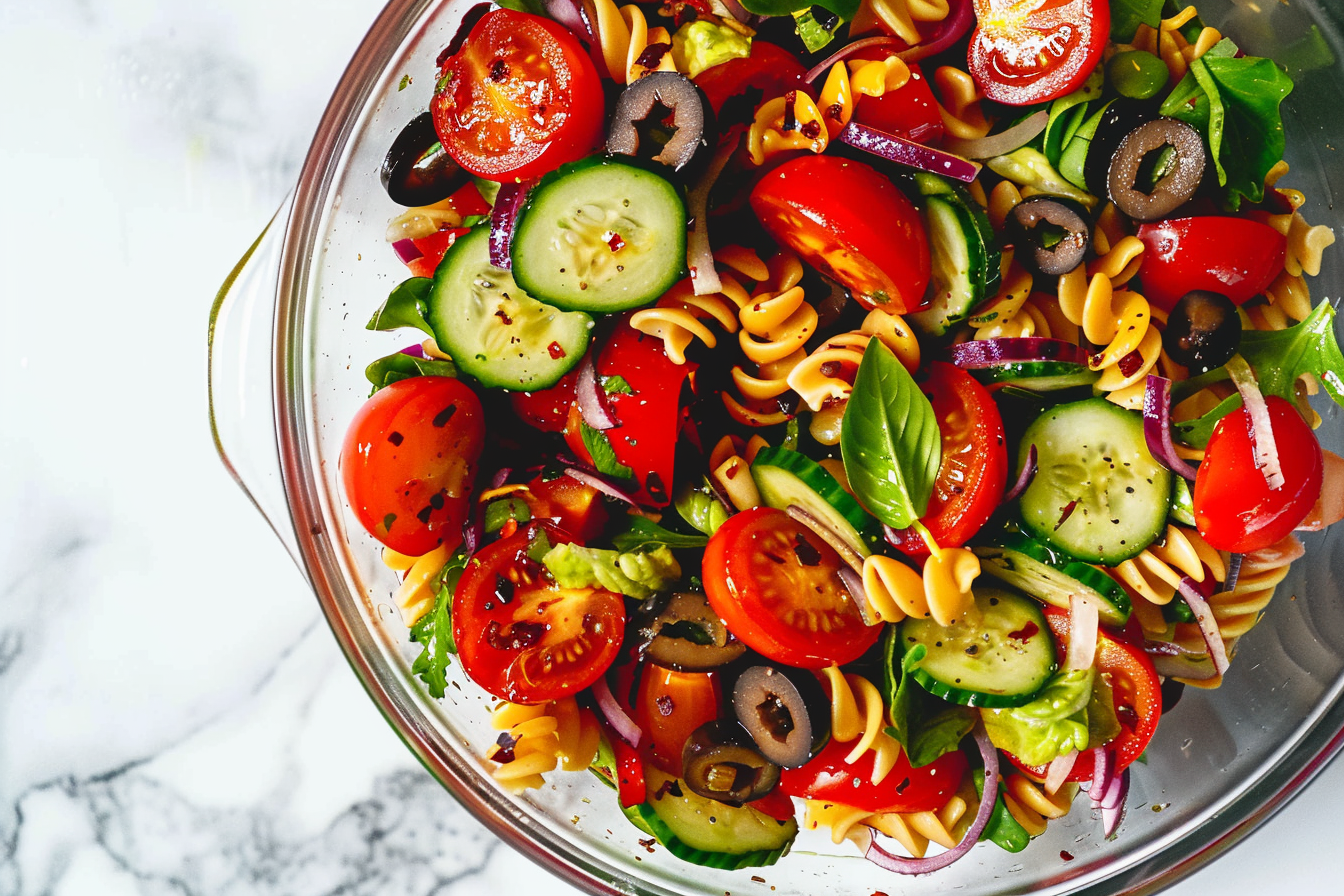Introduction to Pasta Salad Recipe
Embracing the Delight of Pasta Salad:
This pasta salad recipe combines the robustness of pasta with the crispness of fresh vegetables. It’s versatile, making it a favorite for picnics, barbecues, and potlucks. The combination of various textures and flavors creates a pleasing sensation for the taste buds.
The History and Evolution of Pasta Salad
The origins of pasta salad trace back to Italy, where simple pasta dishes were often served cold. Over time, pasta salad evolved, embracing ingredients from various cuisines. Today, it’s a global favorite, with each culture adding its unique twist. For a deeper dive into different pasta salad recipes, check out Pasta Salad Ideas from Food Network.
Why Opt for Pasta Salad?
There are many reasons why pasta salad is a standout choice. Firstly, it’s extremely convenient. It can be prepared in advance, and the flavors often enhance after resting overnight. Secondly, it’s incredibly versatile. You can customize it with various ingredients based on what’s available or your personal tastes. For those looking for healthier options, Healthy Pasta Salad Recipes from EatingWell offer great ideas.
Moreover, pasta salad is a nutritious choice. It combines carbohydrates from the pasta with vitamins and fiber from the vegetables. Adding a protein source like beans, chicken, or cheese can make it a complete meal. For both relaxed family meals and celebratory events, pasta salad is a crowd-pleasing option that satisfies everyone.
In summary, pasta salad is not just a side dish; it’s a versatile and nutritious option that fits any occasion. Embrace the endless possibilities and enjoy creating your unique version of this timeless favorite.
The Basic Recipe
Print
Classic Tri-Colored Pasta Salad
- Total Time: 25 minutes
- Yield: 8 servings 1x
- Diet: Vegetarian
Description
A vibrant and flavorful pasta salad perfect for any occasion. This dish combines colorful vegetables with a zesty Italian dressing, making it a crowd-pleaser.
Ingredients
- 1 pound tri-colored spiral pasta
- 1 (16 ounce) bottle Italian-style salad dressing
- 6 tablespoons salad seasoning mix
- 2 cups cherry tomatoes, diced
- 1 green bell pepper, chopped
- 1 red bell pepper, diced
- ½ yellow bell pepper, chopped
- 1 (2.25 ounce) can black olives, chopped
Instructions
- Cook the pasta: Prepare the pasta according to the package instructions. Once cooked, drain and rinse with cold water to stop the cooking process.
- Mix the dressing: In a large bowl, combine the Italian-style salad dressing with the salad seasoning mix.
- Add the veggies: Toss in the cherry tomatoes, green bell pepper, red bell pepper, yellow bell pepper, and black olives. Mix well to ensure everything is coated with the dressing.
- Combine and chill: Add the cooked pasta to the bowl and toss everything together. Refrigerate for at least 1 hour before serving to let the flavors meld.
Notes
Feel free to adjust the seasoning and vegetables according to your taste. This salad can be made a day in advance and stored in the refrigerator.
- Prep Time: 15 minutes
- Cook Time: 10 minutes
- Category: Salad
- Method: No-Cook
- Cuisine: Italian
Nutrition
- Serving Size: 1 cup
- Calories: 280
- Sugar: 6g
- Sodium: 700mg
- Fat: 12g
- Saturated Fat: 2g
- Unsaturated Fat: 10g
- Trans Fat: 0g
- Carbohydrates: 36g
- Fiber: 4g
- Protein: 6g
- Cholesterol: 0mg
Keywords: Pasta Salad
Enjoy this pasta salad as a delicious and refreshing dish for any gathering. For more tips on making the best pasta salad, visit Pasta Salad Tips from Bon Appétit.
STEPS
Step 1:
Gather all ingredients.

Step 2:
Heat a sizable pot of water with a pinch of salt until it reaches a rolling boil. Add the pasta, stirring intermittently, and cook until it is al dente, approximately 10 to 12 minutes. Rinse with cold water and drain thoroughly.
Step 3:
Blend Italian dressing with salad spice mix until the mixture is smooth and well combined. In a salad bowl, mix together the pasta, tomatoes, bell peppers, and olives.

Step 4:
Pour the dressing over the salad and toss gently to ensure everything is thoroughly coated.

Step 5: Chill the salad in the refrigerator for at least 8 hours or up to overnight.

Step 6:
Enjoy!

Advanced Techniques and Variations
Enhancing Flavors in Pasta Salad Recipe
To elevate your pasta salad, consider marinating the vegetables. This step allows the veggies to absorb more flavors, adding depth to each bite. Fresh herbs like basil, parsley, and cilantro can also make a big difference. ust before serving, add a sprinkle on top for a refreshing burst.
Creative Add-Ins for Pasta Salad
Adding creative ingredients can transform your pasta salad into a unique dish every time. Consider mixing in cheeses like feta or mozzarella for a creamy texture. Nuts such as toasted pine nuts or almonds can add a delightful crunch. For a protein boost, try incorporating grilled chicken, shrimp, or beans. These enhancements not only boost flavor but also make the salad more substantial.
Dressing Options for Pasta Salad
Experimenting with different dressings can keep your pasta salad recipe exciting. While Italian dressing is a classic choice, you can also try a homemade vinaigrette using olive oil, vinegar, and Dijon mustard. For a creamier option, a mix of yogurt, lemon juice, and dill can be delicious. Adjust the acidity and sweetness to suit your taste preferences.
Seasonal Variations of Pasta Salad
Adjusting your pasta salad to the seasons ensures the freshest ingredients are used. In summer, include juicy tomatoes, cucumbers, and fresh corn. In fall, roasted butternut squash and cranberries add a festive touch. Winter can feature hearty ingredients like kale and roasted root vegetables, while spring is perfect for incorporating peas, asparagus, and radishes.
By trying out these advanced techniques and variations, you can experience pasta salad in fresh and thrilling ways. Whether you’re cooking for a regular family meal or a festive gathering, these tips will guarantee you craft a remarkable dish every time. For more pasta salad ideas, visit Pasta Salad Tips from Bon Appétit.
If you’re looking for additional pasta dishes or tips, check out other related recipes on our Cooking White Recipe Blog.

Storage and Maintenance Tips
Proper Storage for Pasta Salad
Proper storage is key to keeping your pasta salad fresh and flavorful. Always store your pasta salad in an airtight container to keep it from drying out or absorbing any unwanted odors from the refrigerator. For storage beyond a couple of days, it’s wise to portion the salad into smaller containers. This method helps maintain quality and makes serving more convenient.
Understanding Pasta Salad Shelf Life Typically
pasta salad remains good in the refrigerator for 3-5 days. Dividing the salad into smaller portions is recommended if you need to store it for several days. If the salad smells off or the vegetables look slimy, it’s best to discard it. Avoid freezing pasta salad, as the texture of the pasta and vegetables can become unappealing when thawed.
Reviving Leftovers
If your pasta salad seems a bit dry after a few days, there are simple ways to revive it. Add a splash of extra dressing or a drizzle of olive oil to bring back its moisture and flavor. This practice helps maintain the salad’s overall quality and makes it easier to grab a quick serving. Mixing in new ingredients, like freshly chopped vegetables or a handful of nuts, can add texture and revitalize the salad.
Tips for Serving
When serving pasta salad at a gathering, it’s helpful to keep it chilled. Typically, pasta salad can last 3-5 days in the refrigerator. If serving outdoors, consider covering the bowl with a lid or plastic wrap to protect it from insects and debris.
By following these storage and maintenance tips, you can enjoy your pasta salad at its best, whether you’re preparing it ahead for a busy week or serving it at a party. Following these guidelines will keep your salad fresh, flavorful, and safe to enjoy.

Dietary Adaptations
Gluten-Free Options for Pasta Salad Recipe
For those with gluten sensitivities, creating a pasta salad that fits your dietary needs is simple. Substitute traditional pasta with gluten-free varieties made from rice, corn, or quinoa. These alternatives maintain the dish’s hearty texture and absorb flavors well. Ensure all ingredients, including the salad dressing, are gluten-free to prevent cross-contamination.
Vegan Variations of Pasta Salad Recipe
Transforming your pasta salad into a vegan-friendly dish requires only a few adjustments. Opt for vegan pasta and dressings free from animal products. Instead of cheese, add nutritional yeast or vegan cheese substitutes for that creamy texture. Beans, chickpeas, or tofu can replace meat, providing a satisfying protein boost. Boost the nutritional value of the salad by adding more fresh vegetables.
Low-Calorie Adjustments
For a lighter pasta salad, focus on reducing high-calorie ingredients without sacrificing flavor. Use whole wheat or legume-based pasta to increase fiber and nutrient content. Swap out traditional dressings for lighter options, like a vinaigrette made with lemon juice, vinegar, and a touch of olive oil. Reduce calorie intake by using less dressing. Also, incorporate plenty of low-calorie vegetables such as cucumbers, bell peppers, and leafy greens to add volume and crunch.
Customizing for Special Diets
Adjusting your pasta salad to fit specific dietary requirements can be straightforward and delicious. For a protein-packed variation, try incorporating grilled chicken, shrimp, or boiled eggs. To make it dairy-free, leave out the cheese and choose a dairy-free dressing. For a low-carb alternative, replace the pasta with spiralized veggies like zucchini or cucumber, keeping the dish’s essence while aligning with dietary preferences.
By customizing your pasta salad to accommodate various dietary preferences, you make it accessible for everyone to enjoy. These adaptations not only make the salad inclusive but also add exciting new flavors and textures, keeping your meals interesting and health-conscious.

Frequently Asked Questions (FAQs)
Common Questions About Pasta Salad Recipe
Pasta salad is a versatile dish, but questions often arise when making it. A common query is how to keep pasta from becoming too soft. The solution is to cook the pasta until it’s just al dente, then rinse it with cold water immediately after draining. This halts the cooking process and preserves a firmer texture.
Troubleshooting Issues
Another common issue is bland pasta salad. To avoid this, ensure your dressing is well-seasoned and consider adding herbs, spices, or a splash of vinegar for extra zing. If your salad lacks texture, mix in crunchy elements like nuts, seeds, or fresh vegetables.
Serving Suggestions
People often wonder how to serve pasta salad recipe at different events. For casual gatherings, it works well as a side dish. However, you can easily transform it into a main course by adding protein sources such as grilled chicken, shrimp, or beans. This adds more body to the salad, making it more fulfilling.
Keeping Pasta Salad Fresh
A recurring question is how to keep pasta salad fresh for longer periods. Storing the salad in an airtight container in the refrigerator is crucial.If you’re planning to prepare it in advance, store the dressing separately and only mix it in right before serving. This method ensures the pasta doesn’t soak up too much liquid and turn mushy.
Adjusting for Dietary Needs
Another frequent inquiry involves adapting pasta salad for specific dietary requirements. As mentioned earlier, using gluten-free pasta, vegan dressings, and lighter ingredients can cater to different diets without compromising flavor.
By tackling these frequent questions and troubleshooting tips, you can consistently make a successful pasta salad. Whether you’re preparing it for a quick meal or a large gathering, these tips will help you create a delicious and enjoyable dish every time.

Conclusion and Additional Resources
Recap of Key Points
In conclusion, pasta salad recipe is a delightful and versatile dish that can be customized to suit any taste or dietary requirement. From understanding the basics to exploring advanced techniques, we’ve covered how to make the most out of this beloved dish. Whether you’re looking to enhance flavors, add creative ingredients, or adapt the recipe for specific diets, the possibilities are endless.
Encouragement to Experiment
Don’t be afraid to experiment with your pasta salad. Try different dressings, add-ins, and seasonal vegetables to keep the dish exciting. Remember, the best pasta salad is one that reflects your personal preferences and creativity. Seize the chance to personalize it to your liking.
Additional Resources
For those eager to expand their culinary skills further, consider exploring more recipes and tips. There are countless resources available that can provide new inspiration and techniques. Keep experimenting with flavors and textures to discover your perfect pasta salad.
Final Thoughts
Creating pasta salad can be both enjoyable and satisfying. This dish not only tastes fantastic but also offers limitless possibilities for customization. Regardless of whether you’re a beginner or a seasoned cook, there’s always something new to discover and appreciate about making pasta salad. Gather your ingredients, let your creativity shine in the kitchen, and savor the delightful outcome.
By applying the insights and tips from this article, you’ll be well on your way to mastering pasta salad. Enjoy the journey and the delicious dishes you’ll create along the way. Thank you for diving into the world of pasta salad with us. Enjoy cooking!
